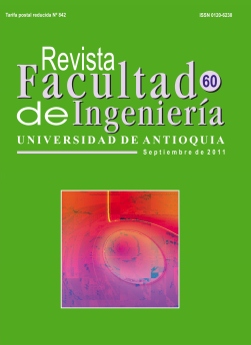Virtual laboratory for simulation and learning of cardiovascular system function in BME studies
DOI:
https://doi.org/10.17533/udea.redin.13747Keywords:
biomedical engineering, interactivity, circulatory system, EJSAbstract
The application of engineering system analysis is a very important field in biomedical engineering (BME) studies: modeling, simulation and control of the most important physiological systems. A virtual laboratory for the analysis and the study of human circulatory system is presented in this paper. This laboratory is based on the compilation of several mathematical models described in the literature. In addition, some model parameters have been tuned by means of experimental data under caffeine stimulus. The computational tool has been built using MATLAB/SIMULINK and EJS, so it combines good computation capabilities with interactivity. The virtual laboratory has been designed in order to understand the operation of the circulatory system under normal conditions, and to predict circulatory variables at different types and levels of stimuli and conditions.
Downloads
References
S. Dormido, S. Dormido Canto, R. Dormido, J. Sánchez, N. Duro. “The role of interactivity in control learning”. International Journal of Engineering Education. Vol. 21. 2005. pp. 1122-1133.
J. D. Bronzino. The Biomedical Engineering Handbook. 2a ed, Ed. CRC Press. Inc. Boca Raton, USA. 2000. pp. 158.1-158.5.
M. Ursino. “Interaction between carotid baroregulation and the pulsating heart: a mathematical model”. Am. J. Physiol. Vol. 44. 1998. pp. 1733-1747. DOI: https://doi.org/10.1152/ajpheart.1998.275.5.H1733
J. V. Freeman, F. E. Dewey, D. M. Hadley, J. Myers, V. F. Froelicher. “Autonomic nervous system interaction with the cardiovascular system during exercise”. Progress in Cardiovascular Diseases. Vol. 48. 2006. pp. 342-362. DOI: https://doi.org/10.1016/j.pcad.2005.11.003
O. V. Ivanova, M. C. K. Khoo. “Simulation of spontaneous cardiovascular variability using PNEUMA”. 26th Annual International Conference of the IEEE Engineering in Medicine and Biology Society. San Francisco. Vol. 2. 2004. pp. 3901-3904.
S. Cavalcanti, E. Belardinelli. “Modeling of cardiovascular variability using a differential delay equation”. IEEE Trans Biomed Eng. Vol. 43. 1996. pp. 982-989. DOI: https://doi.org/10.1109/10.536899
M. Ursino, E. Magosso. “Role of short-term cardiovascular regulation in heart period variability: a modeling study”. Am J Physiol Heart Circ Physiol. Vol. 284. 2003. pp. 1479-1493. DOI: https://doi.org/10.1152/ajpheart.00850.2002
K. H. Wesseling, J. J. Settels, W. Wieling, G. A. Van Montfrans and J. M. Karemaker. “The baromodulation hypothesis, baroreflex resetting and one-over-f blood pressure spectra”. Computer Analysis of Cardiovascular Signals, chapter 8. M. Di Rienzo, G. Mancia, G. Parati, A. Pedotti and A. Zanchetti (editors). Ed. Burke. VA: IOS Press. Amsterdam. 1996. pp. 105-118.
B. J. TenVoorde, Th. J. C. Faes, T. W. J. Janssen, G. J. Scheffer, O. Rompelman. “Respiratory modulation of blood pressure and heart rate studies with a computer model of baroreflex control”. Computer analysis of cardiovascular signals, chapter 9. M. Di Rienzo, G. Mancia, G. Parati, A. Pedotti and A. Zanchetti (editors). Ed. Burke. VA: IOS Press. Amsterdam. 1996. pp. 119- 134.
H. Tsuchimochi, K. Matsukawa, H. Komine, J. Murata. “Direct measurement of cardiac sympathetic efferent nerve activity during dynamic exercise”. Am J Physiol Heart Circ Physiol. Vol. 283. 2002. pp. 1896-1906. DOI: https://doi.org/10.1152/ajpheart.00112.2002
O. A. Timofeeva, D. Sanders, K. Seemann, L. Yang, D. Hermanson, S. Regenbogen, S. Agoos, A. Kallepalli, A. Rastogi, D. Braddy, C. Wells, C. Perraut, F. J. Seidler, T. A. Slotkin, E. D. Levin. “Persistent Behavioral Alterations in Rats Neonatally Exposed to Low Doses of the Organophosphate Pesticide, Parathion”. Brain Res Bull. Vol. 77. 2008. pp. 404-411. DOI: https://doi.org/10.1016/j.brainresbull.2008.08.019
J. C. Shryock, L. Belardinelli. “Adenosine and adenosine receptors in the cardiovascular system: Biochemistry, physiology, and pharmacology”. The American Journal of Cardiology. Vol. 79. 1997. pp. 2-10. DOI: https://doi.org/10.1016/S0002-9149(97)00256-7
B. B. Fredholm. “Adenosine, adenosine receptors and the actions of caffeine”. Pharmacol. Toxicol. Vol. 76. 1995. pp. 93-101. DOI: https://doi.org/10.1111/j.1600-0773.1995.tb00111.x
V. K. Yeragani, M. Tancer, T. Uhde. “Heart rate and QT interval variability: abnormal alpha-2 adrenergic function in patients with panic disorder”. Psychiatry Research. Vol. 121. 2003. pp. 185-196. DOI: https://doi.org/10.1016/S0165-1781(03)00235-X
Y. Huang “An improved simplex method for function minimization.” IEEE Int. Conf. Systems, Man and Cybernetics Beijing. Vol. 3. 1996. pp. 1702-1705.
F. Esquembre. Creación de simulaciones interactivas en Java. Ed. Pearson Education -Prentice Hall. Madrid. 2004. pp. 19 -352.
J. Sánchez, F. Esquembre, C. Martín, S. Dormido, R. Dormido, S. Dormido-Canto, R. Pastor. “Easy java simulations: an open-source tool to develop interactive virtual laboratories using matlab/simulink”. International Journal of Engineering Education. Vol. 21. 2005. pp. 798-813.
Downloads
Published
How to Cite
Issue
Section
License
Copyright (c) 2018 Revista Facultad de Ingeniería

This work is licensed under a Creative Commons Attribution-NonCommercial-ShareAlike 4.0 International License.
Revista Facultad de Ingeniería, Universidad de Antioquia is licensed under the Creative Commons Attribution BY-NC-SA 4.0 license. https://creativecommons.org/licenses/by-nc-sa/4.0/deed.en
You are free to:
Share — copy and redistribute the material in any medium or format
Adapt — remix, transform, and build upon the material
Under the following terms:
Attribution — You must give appropriate credit, provide a link to the license, and indicate if changes were made. You may do so in any reasonable manner, but not in any way that suggests the licensor endorses you or your use.
NonCommercial — You may not use the material for commercial purposes.
ShareAlike — If you remix, transform, or build upon the material, you must distribute your contributions under the same license as the original.
The material published in the journal can be distributed, copied and exhibited by third parties if the respective credits are given to the journal. No commercial benefit can be obtained and derivative works must be under the same license terms as the original work.










 Twitter
Twitter